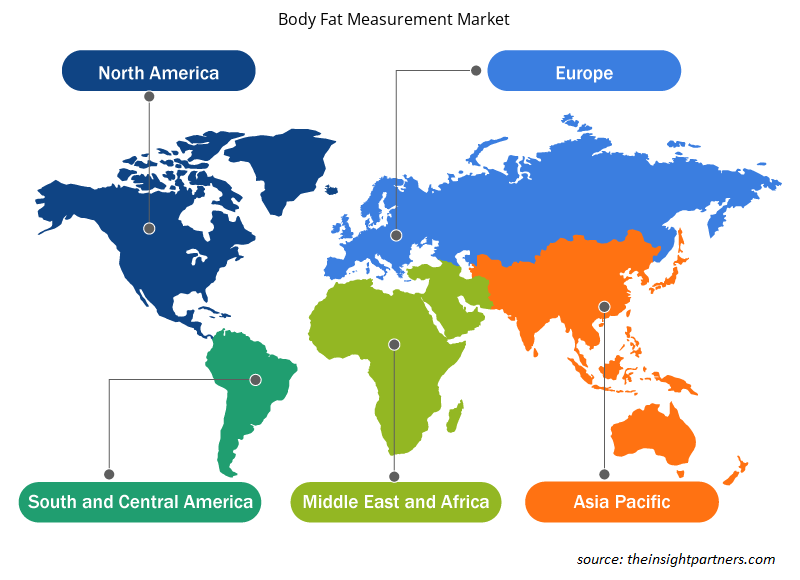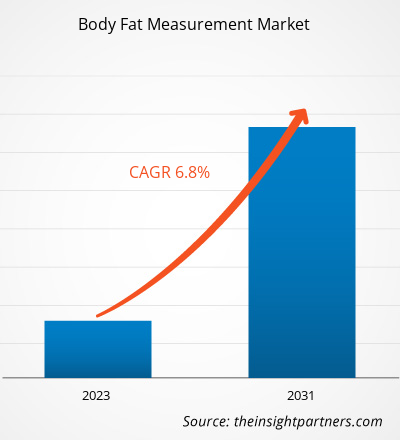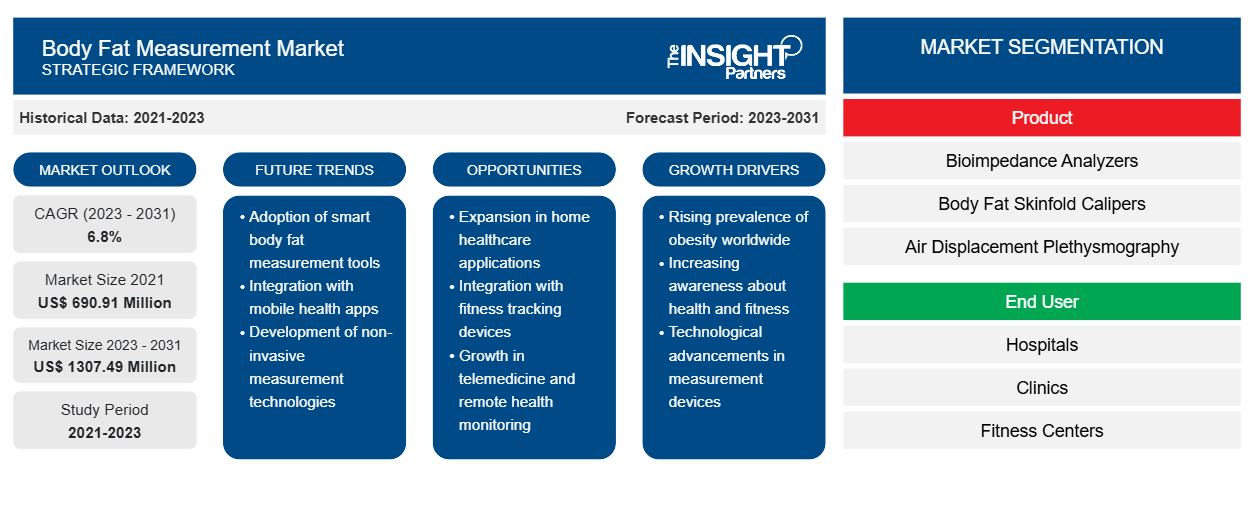El tamaño del mercado de medición de grasa corporal se estimó en US$ 690,91 millones en 2021 y US$ XX millones en 2023 y se espera que alcance los US$ 1307,49 millones para 2031; se estima que registrará una CAGR del 6,8% hasta 2031. La creciente incidencia de ECV y enfermedades neurológicas, los avances tecnológicos, las iniciativas gubernamentales hacia la prevención de enfermedades y el escenario favorable de reembolso médico son factores que impulsan el crecimiento del mercado de medición de grasa corporal. Además, es probable que el creciente porcentaje de población obesa en todo el mundo y el creciente número de enfermedades crónicas sigan siendo tendencias clave del mercado de medición de grasa corporal.
Análisis del mercado de medición de la grasa corporal
La obesidad es una disfunción metabólica y está asociada a una amplia gama de enfermedades crónicas, que causan un aumento sustancial en la mortalidad y la comorbilidad. El porcentaje de la población obesa que se somete a pruebas regulares de composición corporal está aumentando rápidamente. Las ventas de analizadores de composición corporal han observado un patrón creciente debido a la susceptibilidad de la población obesa a los trastornos del estilo de vida. Según la Actualización de la OCDE sobre Obesidad de 2017, los niveles de obesidad son principalmente altos en América del Norte. Se espera que los niveles de obesidad sean particularmente altos en los Estados Unidos, México e Inglaterra, donde se proyecta que el 47%, el 39% y el 35% de la población será obesa en 2030. Se estima que el nivel de obesidad en Francia casi igualará al de España, con un 21% en 2030. Se espera que la falta de ejercicio, una dieta poco saludable y el rápido crecimiento de la población obesa con un aumento en la percepción negativa de la imagen corporal aumenten la demanda de dispositivos de medición de grasa corporal y analizadores de medición de grasa corporal en el período de revisión. Este factor está impulsando el crecimiento del mercado de medición de grasa corporal.
Descripción general del mercado de medición de grasa corporal
Los analizadores de grasa corporal o los medidores de impedancia son herramientas de medición de la grasa corporal que se utilizan para evaluar con precisión la grasa corporal e identificar los riesgos asociados con la salud debido a cantidades altas o bajas de grasa corporal. Estos dispositivos de medición de la grasa corporal también ayudan a evaluar la eficacia del ejercicio y la ingesta de alimentos y se consideran la prueba de aptitud física más común en gimnasios y clubes de salud.
El mercado mundial de medición de la grasa corporal está segmentado por región en América del Norte, Europa, Asia Pacífico, Oriente Medio y África, y América del Sur y Central. En América del Norte, Estados Unidos es el mercado más grande para la medición de la grasa corporal. La creciente obesidad en la región de América del Norte, los esfuerzos para eliminar la obesidad, la creciente conciencia sobre los efectos secundarios causados por la obesidad, la creciente conciencia sobre la aptitud física y la salud, y la importante presencia de los actores clave en este mercado son algunos de los factores que impulsarán el crecimiento del mercado en América del Norte.
Personalice este informe según sus necesidades
Obtendrá personalización en cualquier informe, sin cargo, incluidas partes de este informe o análisis a nivel de país, paquete de datos de Excel, así como también grandes ofertas y descuentos para empresas emergentes y universidades.
-
Obtenga las principales tendencias clave del mercado de este informe.Esta muestra GRATUITA incluirá análisis de datos, desde tendencias del mercado hasta estimaciones y pronósticos.
Factores impulsores y oportunidades del mercado de medición de la grasa corporal
El aumento de la prevalencia de la obesidad favorece al mercado estadounidense
El crecimiento del mercado de medición de grasa corporal en este país se atribuye a la creciente prevalencia de la obesidad en este país. Es probable que las crecientes iniciativas y esfuerzos para reducir la obesidad mejoren el mercado de medición de grasa corporal. En 2010, Michelle Obama inició su campaña Let's Move para luchar contra la obesidad infantil . Esta iniciativa incluye un programa llamado "Salad Bars to Schools (SB2S)" donde se donan barras de ensalada a las escuelas de EE. UU. para desarrollar buenos hábitos alimenticios en las primeras etapas de la vida. Además, hay varias estrategias adoptadas en los EE. UU. para crear un entorno saludable. Por ejemplo, hay comunidades que apoyan la actividad física y se conocen como comunidades activas. Por ejemplo, Active People, Healthy Nation es una iniciativa que se enfoca en ayudar a 27 millones de estadounidenses a volverse más activos físicamente para 2027. Su objetivo es mover a 15 millones de adultos de inactivos (sin actividad) a actividades de intensidad moderada como caminar a paso ligero y andar en bicicleta en su vida diaria. Por lo tanto, es probable que la creciente prevalencia de la obesidad, el creciente número de iniciativas, los avances tecnológicos de los actores del mercado y la creciente industria de la salud y el fitness mejoren el crecimiento del mercado durante el período de pronóstico.
Iniciativas tomadas por el gobierno: una oportunidad para el mercado de medición de grasa corporal
Varias políticas federales, estatales y locales han comenzado a abordar los factores complejos que afectan la relación entre la obesidad, la alimentación saludable y el ejercicio. En todo el mundo se están implementando iniciativas que involucran a la industria y al gobierno en la promoción de una alimentación saludable y el aumento de las opciones de alimentos saludables. Muchas ciudades están participando en debates y proyectos diseñados para promover la actividad física entre sus residentes. Además, el Acuerdo de Responsabilidad de Salud Pública del Reino Unido, la Guía de Peso Saludable, la campaña Make Healthy Normal, el Programa de Reducción de Sal de la Autoridad de Seguridad Alimentaria de Irlanda y la Acción sobre el Azúcar del Reino Unido, entre otros, son algunos de los programas que apuntan a las empresas potenciales y otras organizaciones influyentes para hacer una contribución sustancial a la mejora de la salud pública al ayudar a las personas a tomar decisiones informadas y equilibradas que las ayudarán a llevar una vida más saludable.
Es probable que iniciativas como esta en los últimos años generen oportunidades de crecimiento atractivas para el mercado de medición de grasa corporal.
Análisis de segmentación del informe de mercado de medición de grasa corporal
Los segmentos clave que contribuyeron a la derivación del análisis del mercado de medición de grasa corporal son el producto y el usuario final.
- Según el producto, el mercado de medición de la grasa corporal se segmenta en analizadores de bioimpedancia, calibradores de pliegues cutáneos de grasa corporal, pletismografía por desplazamiento de aire y absorciometría de rayos X de energía dual. El segmento de analizadores de bioimpedancia tuvo la mayor participación del mercado, y se espera que el segmento registre la CAGR más alta del mercado durante el período de pronóstico. El análisis de bioimpedancia es un método no invasivo, de bajo costo y el más utilizado para mediciones de composición corporal y sistemas de evaluación de atención médica. El análisis de bioimpedancia en la práctica médica se suma a la estimación de los compartimentos corporales para evaluar el cambio continuo en el estado nutricional de los pacientes hospitalizados y para monitorear el riesgo nutricional en pacientes ambulatorios. Se han logrado nuevos avances en la antropometría tradicional con el desarrollo de sistemas de escaneo óptico automatizados, que pueden proporcionar rápidamente dimensiones corporales como longitud, anchura y circunferencia y algunos estudios de validación han demostrado que estos métodos ópticos se comparan bien con los métodos de referencia, aunque se requieren más refinamientos de los métodos. Se han logrado nuevos avances en la antropometría tradicional con el desarrollo de sistemas de escaneo óptico automatizados, que pueden proporcionar rápidamente dimensiones corporales como longitud, anchura y circunferencia, y algunos estudios de validación han demostrado que estos métodos ópticos se comparan bien con los métodos de referencia, aunque se requieren más refinamientos de los métodos. Como los monitores de grasa corporal por impedancia bioeléctrica utilizan corriente eléctrica de bajo voltaje, estos están ampliamente disponibles para uso doméstico y en gimnasios. Además, existe un amplio espectro de utilización de la bioimpedancia en los centros de atención médica, como el pronóstico de enfermedades y el monitoreo del estado vital del cuerpo. Por lo tanto, debido a su amplia aplicación, es probable que la demanda de analizadores de bioimpedancia aumente durante el período de pronóstico.
- Según el usuario final, el mercado de medición de grasa corporal está segmentado en hospitales, clínicas y gimnasios. En 2023, el segmento de hospitales tenía la mayor participación del mercado. Sin embargo, se espera que el segmento de gimnasios registre la CAGR más alta del mercado durante el período de pronóstico. Se espera que la creciente prevalencia de la osteoporosis aumente la adopción de la absorciometría de rayos X de energía dual (DEXA) en varios hospitales. Los hospitales han incluido las pruebas de composición corporal como una parte crucial de los programas de atención al paciente y bienestar. En los últimos años, el número de clubes de fitness ha aumentado considerablemente como resultado del creciente enfoque en la salud y el fitness entre las personas. Según un estudio realizado por la Asociación Internacional de Salud, Raqueta y Clubes Deportivos (IHRSA) como parte del Consejo de Actividad Física (PAC), aproximadamente 1 de cada 5 estadounidenses (20,8%) se une al menos a un club o estudio de salud en EE. UU. En gimnasios y centros de bienestar, los analizadores de composición corporal no solo miden la cantidad de grasa corporal para perder peso, sino que también brindan una evaluación completa de la composición corporal para mantener la salud. Por lo tanto, debido a los factores antes mencionados, es probable que el segmento de centros de fitness crezca en el período de pronóstico.CAGR in the market during the forecast period. The growing prevalence of osteoporosis is expected to increase the adoption of Dual-energy X-ray absorptiometry (DEXA) in various hospitals. Hospitals have included body composition testing as a crucial part of patient care and wellness programs. Over the past few years, the number of fitness clubs have increased considerably as a result of the growing focus on health and fitness among individuals. Based on a study conducted by the International Health, Racquet & Sports club Association (IHRSA) as part of the Physical Activity Council (PAC), about 1 out of 5 Americans (20.8%) joins at least one US health club or studio. At gyms and wellness centers, body composition analyzers not only measure the amount of body fat for weight loss but also deliver complete body composition assessment to maintain health. Therefore, owing to such aforementioned factors the fitness centers segment is likely to grow in the forecast period.
Análisis de la cuota de mercado de medición de la grasa corporal por geografía
El alcance geográfico del informe del mercado de medición de grasa corporal está segmentado principalmente en cinco regiones: América del Norte, Asia Pacífico, Europa, Medio Oriente y África, y América del Sur / América del Sur y Central.
La región de Asia Pacífico fue la que más rápido creció en el mercado mundial de medición de grasa corporal y se proyectó que crecería a un ritmo más rápido durante el período de pronóstico. El crecimiento de la participación de mercado de medición de grasa corporal en esta región se debe principalmente al aumento de la población joven, el aumento de los casos de obesidad y otros factores. Además, los países con grandes poblaciones como China e India, la creciente carga de obesidad y sobrepeso y la creciente industria del fitness. Por lo tanto, existe un enorme potencial para el mercado de medición de grasa corporal durante el período de pronóstico debido a las razones mencionadas anteriormente. Según el estudio publicado en Annals of Internal Medicine, la prevalencia de la obesidad en China se ha triplicado y la obesidad abdominal ha aumentado en un 50% en la última década. El 14% de los hombres y el 14,1% de las mujeres eran obesos. Además, según el estudio "Obesidad en China: causas y soluciones", una de cada cinco personas que padecen obesidad en todo el mundo son chinas. La obesidad abdominal es la principal causa de enfermedad cardiovascular en la India. Varios estudios de investigación han informado que en la India la obesidad en la India es más frecuente en mujeres que en hombres. El gobierno indio está tomando varias medidas para abordar el problema de la obesidad infantil en el país. Por ejemplo, el Hospital JJ de Bombay, un hospital público, está estableciendo un departamento ambulatorio para niños y adolescentes con el fin de limitar el creciente problema de la obesidad infantil en el país. El Ministerio de Salud de la India también está apoyando esta iniciativa del hospital subvencionando el tratamiento de los casos graves que requieren cirugía. Por lo tanto, es probable que la creciente prevalencia de la obesidad, los esfuerzos del gobierno por reducirla y la creciente conciencia de la salud entre la población favorezcan el crecimiento del mercado en la región durante el período previsto.
Perspectivas regionales del mercado de medición de grasa corporal
Los analistas de Insight Partners explicaron en detalle las tendencias y los factores regionales que influyen en el mercado de medición de grasa corporal durante el período de pronóstico. Esta sección también analiza los segmentos y la geografía del mercado de medición de grasa corporal en América del Norte, Europa, Asia Pacífico, Medio Oriente y África, y América del Sur y Central.

- Obtenga datos regionales específicos para el mercado de medición de grasa corporal
Alcance del informe de mercado sobre medición de grasa corporal
| Atributo del informe | Detalles |
|---|---|
| Tamaño del mercado en 2021 | US$ 690,91 millones |
| Tamaño del mercado en 2031 | US$ 1307,49 millones |
| CAGR global (2023 - 2031) | 6,8% |
| Datos históricos | 2021-2023 |
| Período de pronóstico | 2023-2031 |
| Segmentos cubiertos |
Por producto
|
| Regiones y países cubiertos |
América del norte
|
| Líderes del mercado y perfiles de empresas clave |
|
Densidad de actores del mercado de medición de grasa corporal: comprensión de su impacto en la dinámica empresarial
El mercado de medición de grasa corporal está creciendo rápidamente, impulsado por la creciente demanda de los usuarios finales debido a factores como la evolución de las preferencias de los consumidores, los avances tecnológicos y una mayor conciencia de los beneficios del producto. A medida que aumenta la demanda, las empresas amplían sus ofertas, innovan para satisfacer las necesidades de los consumidores y aprovechan las tendencias emergentes, lo que impulsa aún más el crecimiento del mercado.
La densidad de actores del mercado se refiere a la distribución de las empresas o firmas que operan dentro de un mercado o industria en particular. Indica cuántos competidores (actores del mercado) están presentes en un espacio de mercado determinado en relación con su tamaño o valor total de mercado.
Las principales empresas que operan en el mercado de medición de grasa corporal son:
- N / A
Descargo de responsabilidad : Las empresas enumeradas anteriormente no están clasificadas en ningún orden particular.

- Obtenga una descripción general de los principales actores clave del mercado de medición de grasa corporal
Noticias y desarrollos recientes del mercado de medición de grasa corporal
El mercado de medición de grasa corporal se evalúa mediante la recopilación de datos cualitativos y cuantitativos posteriores a la investigación primaria y secundaria, que incluye publicaciones corporativas importantes, datos de asociaciones y bases de datos. A continuación, se incluye una lista de los avances en el mercado de medición de grasa corporal y las estrategias:
- En octubre de 2022, Inbody Ltd. se asoció con iLoveKickboxing para brindar pruebas de composición corporal en instalaciones de Canadá y EE. UU. (Fuente: Inbody Ltd., comunicado de prensa, 2022)
Cobertura y resultados del informe de mercado sobre medición de grasa corporal
El informe “Tamaño y pronóstico del mercado de medición de grasa corporal (2021-2031)” proporciona un análisis detallado del mercado que cubre las siguientes áreas:
- Tamaño del mercado y pronóstico a nivel global, regional y nacional para todos los segmentos clave del mercado cubiertos bajo el alcance
- Dinámica del mercado, como impulsores, restricciones y oportunidades clave
- Principales tendencias futuras
- Análisis detallado de las cinco fuerzas de Porter y PEST y FODA
- Análisis del mercado global y regional que cubre las tendencias clave del mercado, los principales actores, las regulaciones y los desarrollos recientes del mercado.
- Análisis del panorama de la industria y de la competencia que abarca la concentración del mercado, el análisis de mapas de calor, los actores destacados y los desarrollos recientes
- Perfiles detallados de empresas
- Análisis histórico (2 años), año base, pronóstico (7 años) con CAGR
- Análisis PEST y FODA
- Tamaño del mercado, valor/volumen: global, regional y nacional
- Industria y panorama competitivo
- Conjunto de datos de Excel
Informes recientes
Informes relacionados
Testimonios
Razón para comprar
- Toma de decisiones informada
- Comprensión de la dinámica del mercado
- Análisis competitivo
- Información sobre clientes
- Pronósticos del mercado
- Mitigación de riesgos
- Planificación estratégica
- Justificación de la inversión
- Identificación de mercados emergentes
- Mejora de las estrategias de marketing
- Impulso de la eficiencia operativa
- Alineación con las tendencias regulatorias























 Obtenga una muestra gratuita para - Mercado de medición de grasa corporal
Obtenga una muestra gratuita para - Mercado de medición de grasa corporal